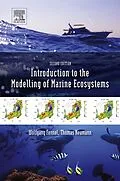Introduction to the Modelling of Marine Ecosystems, Second Edition provides foundational information on the construction of chemical and biological models - from simple cases to more complex biogeochemical models and life cycle resolving model components. This step-by-step approach to increasing the complexity of the models allows readers to explore the theoretical framework and become familiar with the models even when they have limited experience in mathematical modeling. Introduction to the Modelling of Marine Ecosystems shows how biological model components can be integrated into three dimensional circulation models and how such models can be used for numerical experiments. - Covers the marine food web from nutrients, phytoplankton to higher trophic levels - Presents information on the response of marine systems to external pressures as seen in physical biological models - Provides an extended discussion of unifying theoretical concepts and of physical biological interaction - Covers higher trophic levels, in particular multi-species fish models and their interaction with the biogeochemical models - Offers MATLAB scripts on a companion website for many of the described example models to facilitate reproduction of the findings in the book and guide reader to writing own code
Autorentext
Dr. Wolfgang Fennel is professor emeritus of physical oceanography at the University of Rostock and he was head of the section of physical oceanography of the Baltic Sea Research Institute, (IOW). His background is theoretical oceanography and he is a specialist in oceanic circulation and wave processes. He is also working on the coupling of physics and marine biology. Wolfgang Fennel was President of SCOR (2008-2012) and is now Past SCOR President until 2016. He promoted interdisciplinary co-operation.
Klappentext
Introduction to the Modelling of Marine Ecosystems, Second Edition provides foundational information on the construction of chemical and biological models - from simple cases to more complex biogeochemical models and life cycle resolving model components. This step-by-step approach to increasing the complexity of the models allows readers to explore the theoretical framework and become familiar with the models even when they have limited experience in mathematical modeling. Introduction to the Modelling of Marine Ecosystems shows how biological model components can be integrated into three dimensional circulation models and how such models can be used for numerical experiments.
- Covers the marine food web from nutrients, phytoplankton to higher trophic levels
- Presents information on the response of marine systems to external pressures as seen in physical biological models
- Provides an extended discussion of unifying theoretical concepts and of physical biological interaction
- Covers higher trophic levels, in particular multi-species fish models and their interaction with the biogeochemical models
- Offers MATLAB scripts on a companion website for many of the described example models to facilitate reproduction of the findings in the book and guide reader to writing own code
Inhalt
- Preface
- Preface of the First Edition
- Chapter 1: Introduction
- 1.1 Models of marine ecosystems
- 1.2 Models from nutrients to fish
- Chapter 2: Chemical-Biological Models
- 2.1 Chemical-biological processes
- 2.2 Simple models
- 2.3 Simple plankton models for the ocean
- Chapter 3: More Complex Models
- 3.1 Competition
- 3.2 Several functional groups
- 3.3 N2 fixation
- 3.4 Denitrification
- Chapter 4: Modelling Life Cycles of Copepods and Fish
- 4.1 Growth and stage duration
- 4.2 Stage-resolving models of copepods
- 4.3 Experimental simulations
- 4.4 A fish model
- Chapter 5: Physical-Biological Interaction
- 5.1 Irradiance
- 5.2 Coastal ocean dynamics
- 5.3 Advection-diffusion equation
- 5.4 Upscaling and downscaling
- 5.5 Resolution of processes
- Chapter 6: Coupled Models
- 6.1 Introduction
- 6.2 Regional to global models
- 6.3 Circulation models
- 6.4 Baltic sea
- 6.5 Description of the model system
- 6.6 Simulation of the annual cycle
- 6.7 Simulation of the decade 1980-1990
- 6.8 A load reduction experiment
- 6.9 Projection of future changes
- 6.10 Tracking of elements
- 6.11 Discussion
- Chapter 7: Circulation Model, Copepods and Fish
- 7.1 Recruitment (Match-Mismatch)
- 7.2 Copepods in the baltic sea model
- 7.3 Three-dimensional simulations
- 7.4 Modelling of behavioural aspects
- 7.5 Fish in a three-dimensional model
- 7.6 Ergom: A Biogeochemical Model for Regional Seas
- Chapter 8: A Brief Introduction to MATLAB
- 8.1 Fundamentals
- 8.2 Ordinary differential equations
- 8.3 Miscellaneous
- Appendix: Content of the Booksite
- Bibliography
- Index
